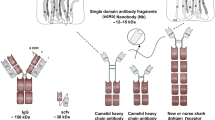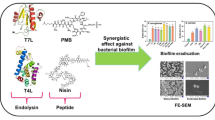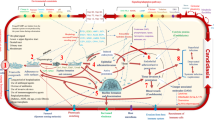Conclusion
This review has considered various aspects of the molecular cross-talks that occur between bacteria and their host eukaryotic cell targets. We have paid particular attention to the determinism of the types of interaction (i.e., association, adherence, invasion) and tried to get across the idea that the nature of the ligand (bacterium)-receptor (host-cell) complex will decide of the outcome of the interaction. Once intracellular, invasive bacteria have evolved different strategies to survive, multiply and spread. In particular we have developed the model ofS. flexneri infection, which is a pradigm of a bacterium that gains access to the host-cell cytoplasm. This certainly allowsS. flexneri to elect the first invaded cell as its major site of multiplication, thus making the disease a purely local destructive process.
It is likely that the current progress of molecular and cellular pathogenesis of infectious diseases will greatly help to define more fundamental research topics, especially in domains such as transmembrane signaling, cytoskeletal reorganization, etc. In addition, a lot will be learnt on the biology of the cell itself. Finally, the design of new vaccines will certainly bear more and more on information obtained by molecular and cellular dissection of infectious processes.
Similar content being viewed by others
References
Adams DO, Hamilton TA (1992) Macrophages as destructive cells in host defense. In: Gallin JI, Goldstein IM, Snyderman R (eds) Inflammation: basic principles and clinical correlates, 2nd edn. Raven Press, New York
Allaoui A, Mounier J, Prévost MC, Sansonetti PJ (1992)icsB: aShigella flexneri gene necessary for the lysis of protrusions during intercellular spread. Mol Microbiol 6:1605–1616
Allaoui A, Sansonetti PJ, Parsot C (1992) MxiJ, a lipoprotein involved in the secretion ofShigella Ipa invasins, is homologous to YscJ, a secretion factor of theYersinia Yop protein. J Bacteriol 174:7661–7669
Allaoui A, Sansonetti PJ, Parsot C (1993) MxiD, an outer membrane protein necessary for the secretion of theShigella flexneri Ipa invasins. Mol Microbiol 7:59–68
Anderson CL, Guyre PM, Whitin JC, Ryan DH, Looney RJ, Fanger MW (1986) Monoclonal antibodies to Fc-receptors for IgG on human mononuclear phagocytes. Antibody characterization and induction of superoxide production in a monocyte cell line. J Biol Chem 261:12856–12864
Andrews GP, Hromockyj AE, Cokes C, Maurelli AT (1991) Two novel virulence loci,mxiA andmxiB, inShigella flexneri 2a facilitate excretion of invasion plasmid antigens. Infect Immun 59:1997–2005
Auger MJ, Ross JA (1992) The biology of the macrophage. In: Lewis CE, McGee JO'D (eds) The macrophage. IRL Press, Oxford, pp 1–74
Baldwin TJ, Brooks SF, Knutton S, Majarrez HHA, Aitken A, Williams PH (1990) Protein phosphorylation by protein kinase C in HEp-2 cells infected by enteropathogenicEscherichia coli. Infect Immun 58:761–765
Baudry B, Maurelli T, Clerc P, Sadoff JC, Sansonetti PJ (1987) Localization of plasmid loci necessary for the entry ofShigella flexneri into HeLa cells and chracterization of one locus encoding four immunogenic polypeptides. J Gen Microbiol 133:3403–3413
Bernardini ML, Mounier J, d'Hauteville H, Coquis-Rondon M, Sansonetti PJ (1987) Identification oficsA, a plasmid locus ofShigella flexneri that governs bacterial intra- and intercellular spread through interaction with F-actin. Proc Natl Acad Sci USA 86:3867–3871
Bliska JB, Clemens JC, Dixon JE, Falkow S (1992) The Yersinia tyrosine phosphatase: specificity of a bacterial virulence determinant for phosphoproteins in the J744A. I macrophage. J Exp Med 176:1625–1630
Clerc P, Sansonetti PJ (1987) Entry ofShigella flexneri into HeLa cells: evidence for directed phagocytosis involving actin polymerization and myosin accumulation. Infect Immun 55:2681–2688
de Man P, van Kooten C, Aarden L, Engberg I, Linder H, Svanborg-Eden C (1989) Interleukin-6 induced at mucosal surfaces by Gram negative bacterial infection. Infect. Immun 57:3383–3388
Falkow S (1992) Bacterial entry into eucaryotic cells. Cell 65:1099–1102
Falkow S, Isberg RR, Portnoy DA (1992) The interaction of bacteria with mammalian cells. Annu Rev Cell Biol 8:333–363
Falkow S, Isberg RR, Portnoy DA (1992) The interaction of bacteria with mammalian cells. Annu Rev Cell Biol 8:333–363
Fields PI, Groisman EA, Heffron F (1989) ASalmonella locus that controls resistance to microbicidal proteins from phagocytic cells. Science 243:1059–1062
Finlay BB (1990) Cell adhesion and invasion mechanisms in microbial pathogenesis. Curr Opin Cell Biol 2:815–820
Finlay BB, Falkow SB (1989) Common themes in microbial pathogenicity. Microbiol Rev 53:210–230
Francis CL, Starnback MN, Falkow S (1992) Morphological and cytoskeletal changes in epithelial cells occur immediately upon interaction withSalmonella typhimurium grown under low-oxygen conditions. Mol Microbiol 6:3077–3087
Gaillard JL, Berche P, Sansonetti PJ (1986) Transposon mutagenesis is a tool to study the role of hemolysin in the virulence ofListeria monocytogenes. Infect Immun 52:50–55
Gaillard JL, Berche P, Fréhel C, Gouin E, Cossart P (1991) Entry ofListeria monocytogenes into cells is mediated by internalin, a repeat protein reminiscent of surface antigens from Gram-positive cocci. Cell 65:1127–1141
Galan JE, Pace J, Hayman MJ (1992) Involvement of the epidermal growth factor receptor in the invasion of cultured mammalian cells bySalmonella typhimurium. Nature 357:588–589
Galgov EE, Håkansson S, Forsberg Å, Wolf-Watz H (1993) A secreted protein kinase ofYersinia pseudotuberculosis is an indispensable virulence determinant. Nature 361:730–732
Gennaro R, Romeo D, Skerlavaj B, Zanetti M (1991) Neutrophils and eosinophil granules as storage of “defense” proteins. In: Harris JR (eds) Lymphocytes and granulocytes, Vol. 3. New York, Plenum Press, pp 335–368
Goldberg MB, Barzu O, Parsot C, Sansonetti PJ (1993) Unipolar localization and ATPase activity of IcsA, aShigella flexneri protein involved in intracellular movement. J Bacteriol 175:2189–2196
Groisman EA, Chino E, Lipps CJ, Heffron F (1989)Salmonella typhimurium phoP gene is a transcriptional regulator. Proc Natl Acad Sci USA 86:7077–7081
Guan K, Dixon JE (1990) Protein tyrosine-phosphatase activity of an essential virulence determinant inYersinia. Science 249:553–555
Hale TL, Bonventre PJ (1979)Shigella infection of Henle intestinal epithelial cells: role of the bacterium. Infect Immun 24:879–886
Hale TL, Morris RE, Bonventre PF (1979)Shigella infection of Henle intestinal epithelial cells: role of the host-cell. Infect Immun 24:887–894
High N, Mounier J, Prévost MC, Sansonetti PJ (1992) IpaB ofShigella flexneri causes entry into epithelial cells and escape from the phagocytic vacuole. EMBO J 11:1991–1999
Hoepelman AIM, Tuomanen EI (1992) The consequences of microbial attachment: directing host-cell functions with adhesins. Infect Immun 60:1729–1733
Hromockyi AE, Maurelli AT (1989) Identification ofShigella invasion genes by isolation of temperature-regulated 230-01 operon fusions. Infect Immun 57:1391–1398
Isberg RR (1991) Discrimination between intracellular uptake and surface adhesion of bacterial pathogens. Science 252:934–938
Kadurugamuwa JL, Rhode M, Wehland J, Timmis KN (1991) Intercellular spread ofShigella flexneri through a monolayer mediated by membranous protrusions and associated with reorganization of the cytoskeletal protein vinculin. Infect Immun 59:6463–6471
Kathariou S, Metz P, Hof H, Goebel W (1987) Tn916-induced mutations in the hemolysin determinant affecting virulence ofListeria monocytogenes. J Bacteriol 169:1291–1297
Kocks C, Gouin E, Tabouret M, Berche P, Ohayon H, Cossart P (1992)L. monocytogenes- induced actin assembly requires theactA gene product, a surface protein. Cell 68:521–531
Kraehenbühl JP, Neutra MR (1992) Molecular and cellular basis of immunoprotection of mucosal surfaces. Physiol Rev 72:853–879
Majarrez HHA, Amess B, Selers L, Baldwin TJ, Knutton S, Williams PH, Aitken A (1991) Purification of a 20-kDa phosphoprotein from epithelial cells and identification as a myosin light chain-phosphorylation induced by enteropathogenicEscherichia coli and phorbol-ester. FEMS Lett 292:121–127
Makino S, Sasakawa C, Kamata K, Kurata T, Yoshikawa MA (1986) A genetic determinant required for continuous reinfection of adjacent cell on large plasmid ofShigella flexneri. Cell 46:551–555
Maurelli AT, Baudry B, d'Hauteville H, Hale TL, Sansonetti PJ (1985) Cloning of plasmid DNA sequences involved in invasion of HeLa cells byShigella flexneri. Infect Immun 49:164–171
Ménard R, Sansonetti PJ, Parsot C (1993) Nonpolar mutagenesis of theipa genes defines IpaB, IpaC and IpaD as effectors ofShigella flexneri entry into epithelial cells. J Bacteriol (in press)
Mengaud J, Braun-Breton C, Cossart P (1991) Phosphatidylinositol-specific phospholipase C inListeria monocytogenes: a novel type of virulence factor. Mol Microbiol 5:367–372
Michiels T, Vanooteghen J, Lambert de Rouvoit C, China B, Gustin A, Boudry P, Cornells G (1991) Analysis ofvirC, an operon involved in the secretion of Yop proteins byYersinia enterocolitica. J Bacteriol 173:4994–5009
Miller SI, Mekalanos JJ (1990) Constitutive expression of thephoP regulon attenuatesSalmonella virulence and survival within macrophages. J Bacteriol 172:2485–2490
Miller SI, Pulkkinen WS, Selsted ME, Mekalanos JJ (1990) Characterization of defensin resistance phenotypes associated with mutations in the PhoP virulence regulon ofSalmonella typhimurium. Infect Immun 58:3706–3710
Mounier J, Ryter A, Coquis-Rondon M, Sansonetti PJ (1990) Intracellular and cell-to-cell spread of Listeria monocytogenes involves interaction with F-actin in the enterocyte-like cell line Caco-2. Infect Immun 58:1048–1058
Neutra MR, Phillips TL, Mayer EL, Fishkind DJ (1987) Transport of membrane-bound macromolecules by M cells in follicle-associated epithelium of rabbit Peyer's patch. Cell Tissue Res 247:537–546
Pace J, Hayman MJ, Galan JE (1993) Signal transduction and invasion of epithelial cells byS. thyphimurium. Cell 72:505–514
Portnoy DA, Jacks PS, Hinrichs DJ (1988) Role of hemolysin for the intracellular growth ofListeria monocytogenes. J Exp Med 167:1459–1471
Prévost MC, Lesourd M, Arpin M, Vernel F, Mounier J, Hellio R, Sansonetti PJ (1992) Unipolar reorganization of F-actin layer at bacterial division and bundling of actin filaments by plastin correlate with movement ofShigella flexneri. Infect Immun 60:4088–4099
Ravetch JV, Kinet JP (1991) Fc-receptors. Annu Rev Immunol 9:457–492
Rosenshine I, Donnenberg MS, Kaper JB, Finlay BB (1992) Signal transduction between enteropathogenicEscherichia coli (EPEC) and epithelial cells: EPEC induces tyrosine phosphorylation of host-cell proteins to initiate cytoskeletal rearrangement and bacterial uptake. EMBO J 11:3551–3560
Rosquist R, Bolin I, Wolf-Watz H (1988) Inhibition of phagocytosis inYersinia pseudotuberculosis: a virulence plasmid-encoded ability involving the Yop 2b protein. Infect Immun 56:2139–2143
Rosquist R, Forsberg A, Wolf-Watz H (1991) Intracellular targetting of theYersinia YopE cytotoxin in mammalian cells induces actin microfilament disruption. Infect Immun 59:4562–4569
Ruoslathi E (1991) Integrins. J Clin Invest 87:1–5
Sansonetti PJ (1991) Genetic and molecular basis of epithelial cell invasion by Shigella species. Rev Infect Dis 13:285–292
Sansonetti PJ, Kopecko DJ, Formal SB (1982) Involvement of a plasmid in the invasive ability ofShigella flexneri. Infect Immun 35:852–860
Sansonetti PJ, Ryter A, Clerc P, Maurelli AT, Mounier J (1986) Multiplication ofShigella flexneri within HeLa cells: lysis of the phagocytic vacuole and plasmid-mediated contact hemolysis. Infect Immun 51:461–469
Sasakawa C, Kamata K, Sakai T, Makino S, Yamada M, Okada N, Yoshikawa M (1988) Virulence associated genetic regions comprising 31 kb of the 230-kb plasmid inShigella flexneri 2a. J Bacteriol 170:2480–2484
Sasakawa C, Adler B, Tobe T, Okada N, Nagai S, Komatsu K, Yoshikawa M (1989) Functional organization and nucleotide sequence of virulence region-2 on the large virulence plasmid ofShigella flexneri 2a. Mol Microbiol 3:1191–1202
Tilney LG, Portnoy DA (1989) Actin filaments and the growth, movement and spread of the intracellular bacterial parasite,Listeria monocytogenes. J Cell Biol 109:1597–1608
Vasselon T, Mounier J, Prévost MC, Hellio R, Sansonetti PJ (1991) Stress fiber-based movement ofShigella flexneri within cells. Infect Immun 59:1723–1732
Vasselon T, Mounier J, Hellio R, Sansonetti PJ (1992) Movement along actin filaments of the perijunctional area andde novo polymerization of cellular actin are required forShigella flexneri colonization of epithelial Caco-2 cell monolayers. Infect Immun 60:1031–1040
Venkatesan MM, Buysse JM, Kopecko DJ (1988) Characterization of invasion plasmid antigen genes (ipaBCD) fromShigella flexneri. Proc Natl Acad Sci USA 85:9317–9321
Venkatesan MM, Buysse JM, Oaks EV (1992) Surface presentation ofShigella flexneri invasion plasmid antigens requires the products ofspa locus. J Bacteriol 174:990–2001
Wright SD, Silverstein S (1983) Receptors for C3B and C3bi promote phagocytosis but not the release of toxis oxygen radicals from human phagocytes. J Exp Med 158:2076–2023
Author information
Authors and Affiliations
Rights and permissions
About this article
Cite this article
Sansonetti, P.J. Bacterial pathogens, from adherence to invasion: comparative strategies. Med Microbiol Immunol 182, 223–232 (1993). https://doi.org/10.1007/BF00579621
Received:
Issue Date:
DOI: https://doi.org/10.1007/BF00579621




